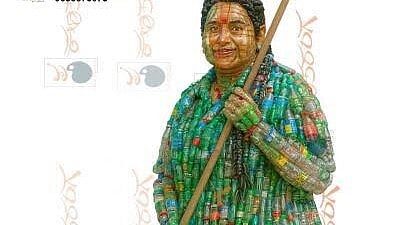
Waste to wonder model of Paurakarmika Woman.
Credit: Mysore City Corporation
Mysuru: Apart from Swachha Dasara initiative for the first time, the Mysuru City Corporation (MCC) is coming up with attractive ‘Waste to Wonder/Resource’ - Artefacts/Models of Nandi and a pourakarmika woman. Pourakarmika woman is planned to be used in Dasara Tableaux and Nandi will be displayed at a Circle during Dasara.
A team of artists, led by D Abhilash, are using about 10,000 plastic bottles, textile waste and e-waste generated in Mysuru for the creative model of Nandi. They are using hundreds of plastic bottles for model a pourakarmika woman according to MCC Assistant Executive Engineer (Environment) K S Mruthyunjaya. With this, the MCC, led by Commissioner Shaikh Tanveer Asif, plans to inspire the citizens to adopt sustainable practices, to reduce waste generation and to promote segregation to achieve their zero waste target.
Mysuru city generates about 550 tonnes per day (tpd) solid waste. That includes 302 tonnes of wet waste and 248 tonnes of dry waste. The MCC is already segregating 100 tpd recyclable solid waste (sw) at its plants.
The Kesare solid waste management (SWM) plant - on 11 acres of land with a capacity to handle 200 tpd - has a dedicated material recovery facility (MRF) to handle 15 tpd dry waste and seven zero waste plants - one each at zone 1, 2, two plants at zone 5, one each at 6, 7, 8 - handling 5 tpd dry waste.
The MCC is also coming up with two mega MRFs with a total capacity to process and separate 204 tonnes of recyclable dry solid waste per day, using manual and mechanical methods to boost their recycling and resource recovery efficiency scientifically. They are coming up with two MRFs under Swachh Bharat Mission 2.0 at a cost of Rs 21.94 crore.
They are coming up with a new MRF with a capacity to process 100 tpd dry waste, at the existing SWM plant on six acres of land in Rayankere (with a capacity to handle 150 tpd of SW). The MCC is coming up with another MRF, with a capacity to process 104 tpd of SW, on the land of the existing SWM plant at Vidyaranyapuram. The capacity of the over 26-year-old centralised SWM plant at Vidyaranyapuram, spread over 15 acres, had reduced from handling 200 tpd to 100 tpd. So, the remodeling work has been taken up at a cost of Rs 13.66 crore, to enhance its capacity to handle 200 tpd.
Processed into compost
In these two MRFs, once the dry waste is received, unusual and bulky items are sent for direct sale or disposal to landfill. Later, biodegradables are separated from recyclables scientifically and processed into compost.
Further, recyclables are sorted out manually or mechanically. Recovered materials like paper, glass, plastics, and metals are baled, temporarily stored, and eventually sold to recycling or manufacturing firms. The inert are sent to cement factories. The remaining residual waste is then disposed of at the landfills.
So with these artefacts, the MCC plans to promote the concept of ‘waste as a resource’ during Dasara. They plan to highlight the MCC’s measures for recycling and to promote recycling.